#hidden fortress
Note
(this is spacekrakens lmao) dude idk anything about like 1950s Japanese cinema, do you have any recommendations? looking for stuff to toss on the watchlist now that I'm a bit burned out on horror (unless you have some horror recs)
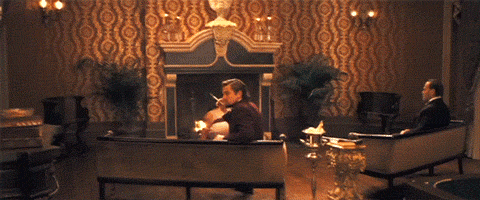
Hey! If you’re curious about Japanese cinema (particularly 1950s), there’s a lot of avenues to explore! Musicals, crime, horror, historical—it all depends on what mood you’re in. (Putting this under a read more because I'm DEFINITELY going to be long posting about this!!!) Hope this is useful to you lol.
(Also noting if anybody wants to add to this list with their own recommendations feel free!!)

With old school Japanese cinema, I’ll always recommend Akira Kurosawa (obviously). He’s made some of the best Japanese movies (and arguably, the best movies of all time imo) and I feel like his work is a good gateway. It’s readily available on physical media/streaming too.
Specifically ‘50s stuff; Hidden Fortress (1958) is a good adventure flick whose structure was swiped for Star Wars, Throne of Blood (1957) is Japanese Macbeth if you like Shakespeare, and if you don’t mind a longer movie Seven Samurai (1954) includes Toshiro Mifune acting like this;
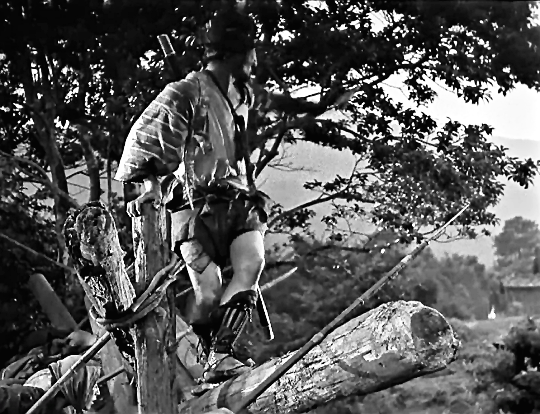
Gotta admit, though—my personal favorites from Kurosawa don’t come from the 1950s; Drunken Angel (1948) and Yojimbo (1961). One has a pathetic gangster as the main lead, the other is just a solid, breezy proto-action film (also has my beloved Unosuke but that's besides the point)
Some personal favorites of mine from the 1950s:
Life of a Horse Trader (1951) is a bittersweet story about a man trying to be a good single father to his son in the backdrop of Hokkaido. He tends not to be great at it. Stars Toshiro Mifune, the most famous face of Japanese cinema and for good reason!
Conflagration/Enjo (1958) is a single Buddhist acolyte’s fall into quiet insanity. Raizo Ichikawa is another amazing actor who I love! Also includes Tatsuya Nakadai who is the GOAT (in my heart).
Godzilla (1954) is AMAZING! If you liked Gozilla Minus One, it took a lot of familiar cues from this movie. It also technically counts as horror, depending on your definition.
Japanese horror from the 1950s:
Ugetsu (1951) (Not one I’ve seen personally, but it’s on Criterion)
The Beast Shall Die (1958) (American Psycho, but in Showa Japan. Tatsuya Nakadai is terrifying in this and absolutely despicable—stylish movie tho!)
Ghost of Yotsuya (1959) (Old-school Japanese ghost story. Honestly, there are so many different versions of this story on film that you can pick which version to watch and go from there—I’m partial to the 1965 version myself, because of the rubber rats and Tatsuya Nakadai playing a crazy person).
The Lady Vampire (1959) is the OG western-style vampire movie from Japan. Plays around with the mythos a lot, but hey our Dracula looks like this;

Misc movies that I think are neat or good gateway movies:
The Samurai Trilogy by Hiroshi Inagaki, which stars Toshiro Mifune as Miyamoto Musashi. Found that people otherwise uninterested in Japanese cinema really enjoyed this!
You Can Succeed, Too (1964) is one of my favorites from the ‘60s, also directed by Eizō Sugawa. A fun satire on the corporate world that's super colorful with catchy songs.
The Sword of Doom (1966) is also another favorite of mine, starring my beloved Tatsuya Nakadai as another bastard man (seriously though Ryunosuke is FASCINATING to me--). Fun gore effects and action scenes!
Kwaidan (1964) is an anthology of Japanese folk tales, labeled a horror film but in that kinda sorta old-school way. Beautifully shot by my favorite Japanese director Masaki Kobayashi (who, if you like this you should seriously check out his other work!)
#thanks for the ask!#akira kurosawa#tatsuya nakadai#toshiro mifune#raizo ichikawa#japan#film#godzilla#hidden fortress#seven samurai#drunken angel#yojimbo#enjo#sword of doom#kwaidan#you can succeed too#samurai trilogy#the lady vampire#ghost of yotsuya#ugetsu#life of a horse trader#throne of blood#ask
22 notes
·
View notes
Text

Ever since i found out Toshiro Mifune turned down the role of obi wan my life has not known peace. Im going to pull a goncharov and gaslight as many people as possible into believing Akira Kurosawa did a remake of Hidden Fortress. In space. With wizards. And laser swords.
#Forbidden screenshot of the best timeline#WE WERE SO CLOSE TO GREATNESS. IT WAS IN THE PALM OF OUR HANDS#mobius double reach around culture appropriation#star wars#obi wan kenobi#luke skywalker#toshiro mifune#hidden fortress#a new hope#akira kurosawa
326 notes
·
View notes
Video
youtube
MATA ASHITA! DEZ CLÁSSICOS DE SAMURAIS PARA CURTIR ESSE MÊS!
#samurai movies#movies#sword of the beast#toshiro mifune#goyokin#yojimbo#akira kurosawa#japanese movies#13 assassins#hidden fortress#harakiri#gateofhell#rashomon#the 47 ronin#seven samurai
3 notes
·
View notes
Text

ecpic computer wallpaper
#heavy tf2#tf2 heavy#team fortress 2#tf2#heavy tf2 tummy#i am NOT normal#like at all#also sorry that some of the watermarks got hidden in the pile of heavys#ive reblogged most of these though so they should be there#big fat man tf2
324 notes
·
View notes
Text
What "The Hidden Fortress" (1958) tells us about the Jedi's status in the Prequels.
In 1999, George Lucas had this to say on BBC Omnibus: A Long Time Ago: The Story of "Star Wars" and then The Phantom Menace's director's commentary.
“I greatly admired Kurosawa, especially the film Hidden Fortress, which told a story from the point of view of two serfs, two slaves...

... peasants who tag along with this famous general and a princess-- y'know, royalty. And the whole story is told from their point of view. And I like that idea.
I like the idea of telling a story from the lowest person's point of view, uh, in the food chain, and that's how the story got to be told by Artoo and Threepio.”
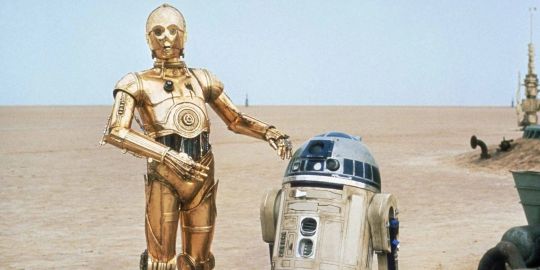
“[The Phantom Menace] is told primarily from the Jedi's point of view, but the story that's being told is essentially the story of Queen Amidala and her plight of having her planet blockaded. As in, say, Episode IV, where the story is told through the eyes of the droids, in this one, it's told through the eyes of the Jedi.”
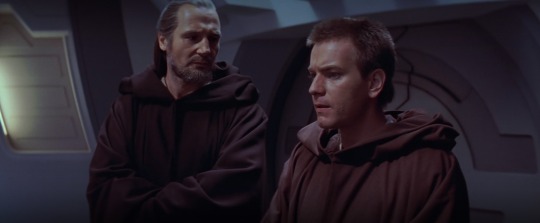
“But [from the moment we get to Coruscant, Anakin and Jar Jar] are standing on the sidelines. It's a little bit a riff on the very first film where the story is told through the point of view of the droids, who were sort of the lowliest characters.”

“And in [Phantom Menace], I'm doing it through - primarily - the two Jedi, but then the secondary characters are also carrying a lot of the weight when the Jedi aren't around.”
George Lucas draws a comparison between lowly characters like Hidden Fortress' peasants Matashichi and Tahei, the droids in A New Hope, as well as the Jedi in The Phantom Menace.
What do they all have in common? They are all the lowest-ranking characters in their respective films. Repeat: the movie frames the Jedi as almost at the bottom of the food chain.
Because of course they are. Functionally, they're just diplomats. They hold no political power whatsoever and barely have any authority .
What little authority the Jedi do have in TPM comes from the Queen's young age, which allows them to ease into a more advisory position, and Qui-Gon's rebellious streak. And even he's explicit about the fact that his mandate has limitations.

The only characters "below" them in status are Jar Jar, an exiled Gungan, and Anakin, who just yesterday was still a slave kid, Artoo the literal object and that's it!
Also the other Prequel films are consistent with this portrayal. Who do we see lower in status than the Jedi? Dexxter Jettster and the clones. Everyone else is pretty much above them.
Yes, the Jedi are part of the system, but they're not as high-ranking as you'd think. Yes, they have Force Powers, but that means squat when put against political power. So, like, to expect the Jedi to...
influence the decisions of the Senate,
wage a war against the Outer Rim to end slavery,
or blatantly refuse an order to join the war effort,
... is incredibly unreasonable.
They're not meant to be seen as "the elite, peering down upon the people from their ivory tower".
They're the servants! Servants of the Republic.
And they're seeing their higher-ups destroy what they should all stand for, but are unable to stop them.
Later on, with The Clone Wars, we are introduced to civilian characters and from their point of view, the Jedi are ultra powerful and are highly placed and "should do more but don't".
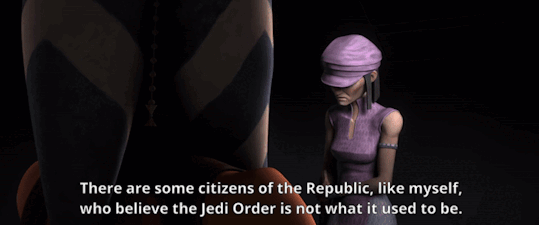
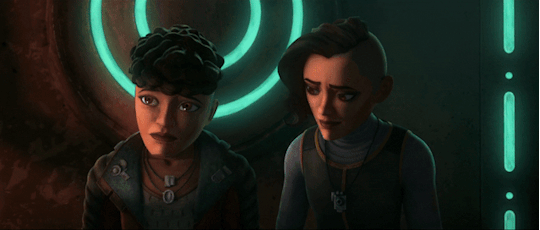
It makes sense that these characters would see the Jedi as 'the elite'. But they don't have the full picture.
We, as the audience, do.
So we know that the reality is more along the lines of the Jedi "should do more but can't".
After all, we are made privy many instances of the Jedi speaking up and trying to change politicians' minds, only to be dismissed and overruled at every turn.
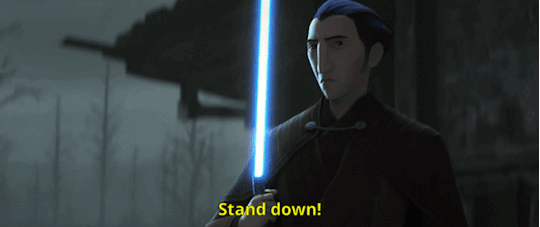
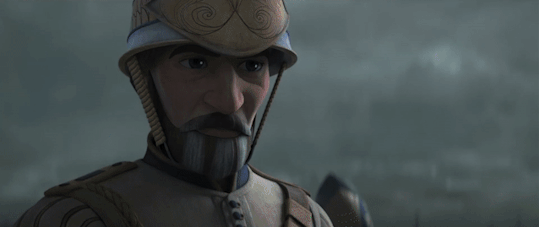




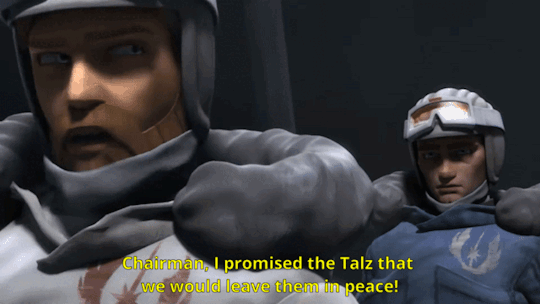
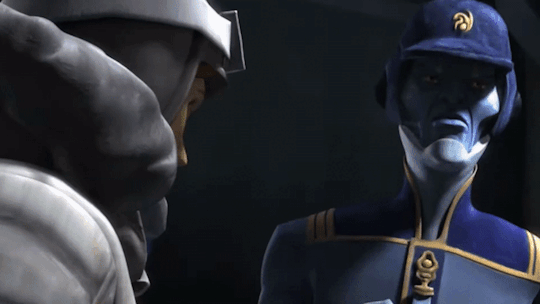

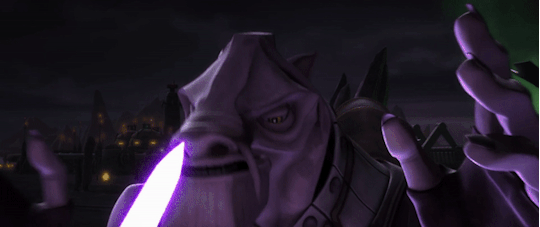
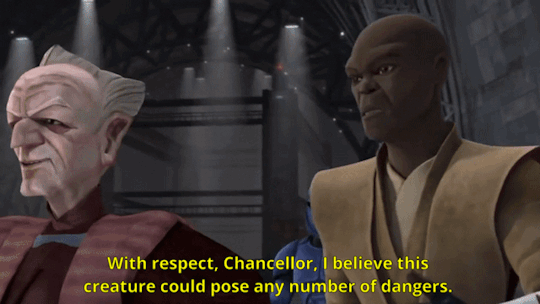
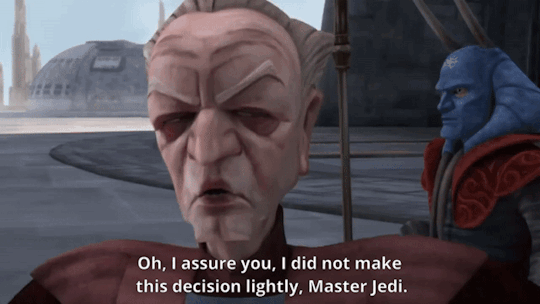


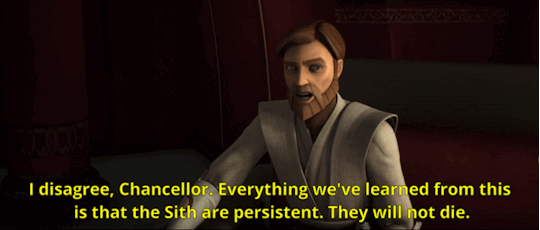

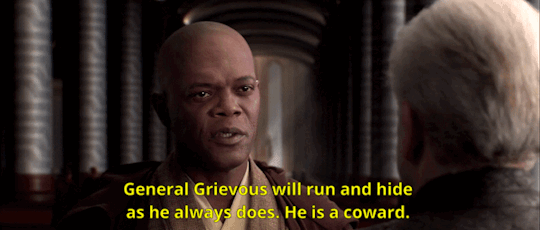
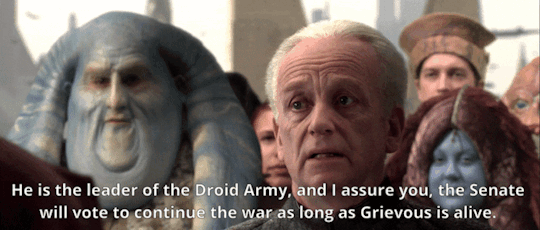
↑ these aren't even all the times we see it happen, btw, there's more examples...
So at some point, if you - as an audience member - see all this and are still saying "the Jedi should've done more!" I really need to know... what more could they have done?
Take control of the Senate?

That'll result in a dictatorship, there's a reason they waited as much as they did before trying to take down Palpatine.
Power corrupts and they're wise enough to know it.
Don't join the Republic in the first place?
George Lucas never frames the Jedi's involvement with the Republic as a bad thing. In the foreword to Shatterpoint (2004), he says their being part of the Republic led to 1,000 years of prosperity.
Where's the issue, then? Well, it's a two-man job and the Jedi's bosses, the Senate, grew corrupt and stopped doing their part. They stopped carrying their end of the couch.
But “no Jedi in the Republic from the get-go” means the Sith will rise to power even faster. Fun!
Stay neutral in the war?
The Separatists were killing civilians and testing weapons on neutral systems, or enslaving them.


The choice put before the Jedi was "do what we tell you and fight, or let people die".
But also, out-of-universe... do you really think Palpatine, genius politician, master of spin, can't re-frame the Jedi staying neutral in a negative light?
When they joined the war, he unleashed propaganda that either directly (on the Separatist side) or indirectly (on the Republic side) framed them as "warmongers who corrupted their values". If they don't join, they're "apathetic cowards who care more about their own values than the lives of the people they're supposed to protect".
So either way, Order 66 comes around, wipes them out and the Republic goes "good riddance".

So what else could they do?
The answer is "not much".
Because the whole point of the narrative is that Palpatine checkmated them by taking the fight to a field the Jedi had no experience in or right to meddle with: politics.
So if you look at these characters who are nowhere near the top of the food chain, and say "well, why didn't they fix things?" I'm sorry to say you're missing the point of the narrative.
Or maybe you do get the point of the narrative and just aren't trying to be fair...

... in which case, at least be consistent and also argue:
"Why didn't Threepio & Artoo do more to save the Rebel crew of the Tantive IV from the stormtrooopers?!"
"Why didn't Matashichi & Tahei do more to save the Akizuki clan?!"
#HINT: the answer to both those rhetorical questions is “there was nothing they could do”#Also while we're on 'Hidden Fortress' - it's also worth pointing out that Qui-Gon and Padmé's dynamic on Tatooine in TPM#is very similar to the dynamic of General Rokurota and Princess Yuki in 'Hidden Fortress'.#The older warrior looking after the royalty teenage girl who is dressed as a peasant so as to not draw attention because she's on the run.#The Hidden Fortress#Akira Kurosawa#George Lucas#Artoo#Threepio#c3po#r2d2#lucas quotes#meta#on the jedi's involvement in the clone wars#in defense of the jedi#jedi order#qui-gon jinn#the phantom menace#star wars#long post
816 notes
·
View notes
Photo


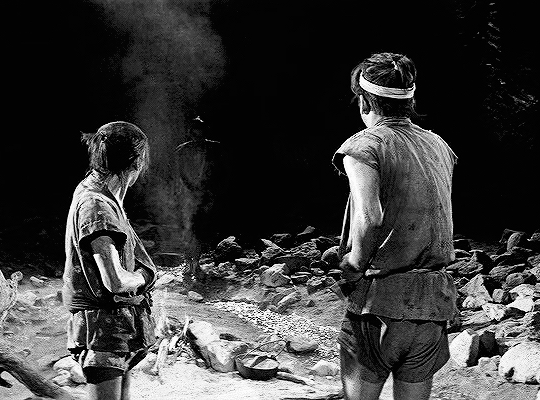






三船敏郎 || THE HIDDEN FORTRESS · 隠し砦の三悪人 (1958) 監督 - 黑沢明
#三船敏郎#toshiro mifune#隠し砦の三悪人#the hidden fortress#classicfilmsource#mine#akira kurosawa#黑沢 明#I LOVE LOVE LOVE how Mifune walked out of darkness and to the light#I love that shot too much
341 notes
·
View notes
Text




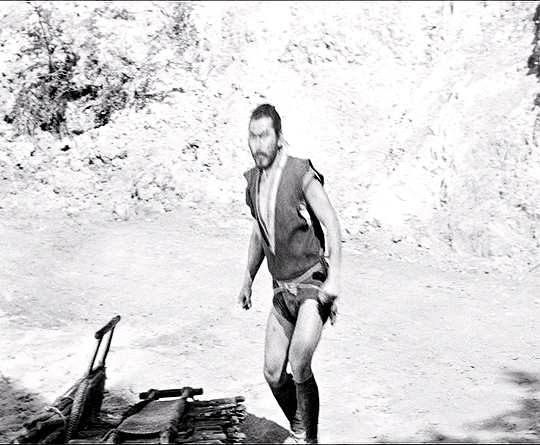


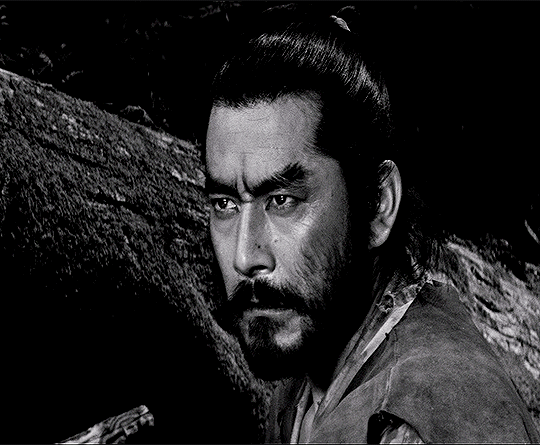
Toshiro Mifune as General Rokurota Makabe in
THE HIDDEN FORTRESS (1958)
dir. Akira Kurosawa
#filmedit#filmgifs#movieedit#moviegifs#dailyworldcinema#classicfilmsource#classicfilmblr#toshiro mifune#akira kurosawa#the hidden fortress#he's fr sexy as hell in this one and for literally no reason
176 notes
·
View notes
Text
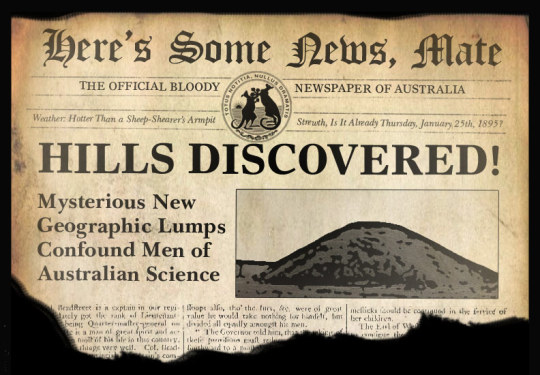

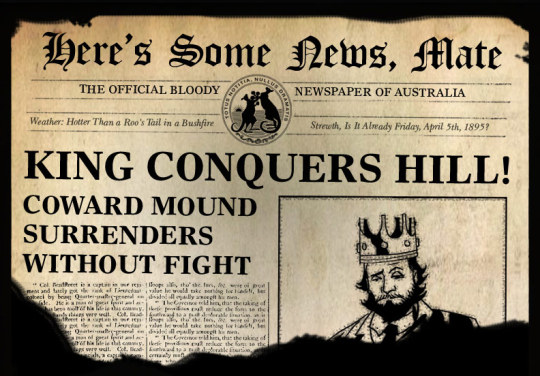

Hidden newspaper headlines from the Classless Update (which introduced King of the Hill as a gamemode) in 2009
(Descriptions in alt text)
#tf2#team fortress 2#don't normally post stuff like this? but i found out abt these 'hidden pages' and hadn't seen anyone post these#so i figured lots of you haven't seen them either!#i'm extrapolating that the 'robin' thing in the last one is a nod to tf2 dev robin walker (who is australian and also a man)
199 notes
·
View notes
Text

Poster for the Akira Kurosawa film The Hidden Fortress (1958).
This film is often touted as one of the influences on George Lucas when he wrote Star Wars (aka A New Hope for you young 'uns).
The story is about two peasants, Tahei and Matashichi, who end up assisting a disguised princess and her loyal general escape from hostile territory.
The peasants, best friends although they constantly bicker, are obvious the influences for C-3PO and R2-D2, while the princess became Leia and the general Obi-Wan Kenobi.
Toshiro Mifune gets top billing, and he gives his usual commanding performance, but this is really Tahei and Matashichi's film. Aside form the connection to Star Wars, it's still a great adventure movie, and well worth watching.
#The Hidden Fortress#General Rokurta Mukabe#Toshiro Mifune#Princess Yuki#Misa Uehara#Tahei#Minoru Chiaki#Matashichi#Kamatari Fujiwara#jidaigeki#chambara#samurai#Akira Kurosawa
52 notes
·
View notes
Photo
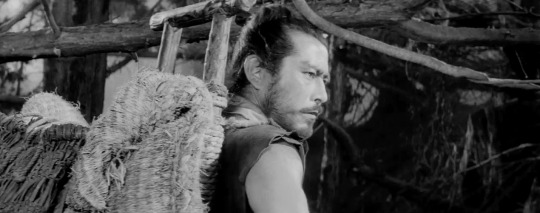
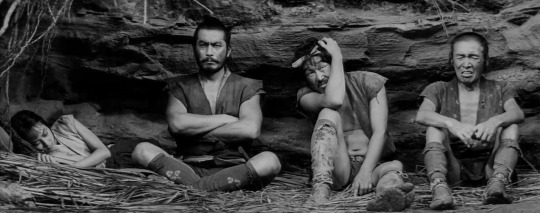
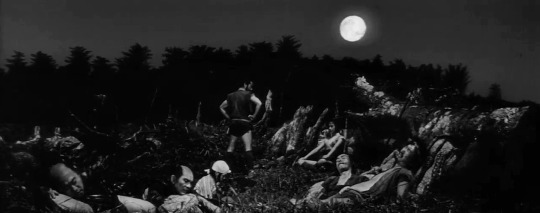



隠し砦の三悪人 The Hidden Fortress , Akira Kurosawa , 1958.
#隠し砦の三悪人#the hidden fortress#akira kurosawa#toshiro mifune#misa uehara#japanese cinema#film#edit#50s#1958
375 notes
·
View notes
Text
Think I said this before? but I did see some people mention they wanted to try watching Akira Kurosawa films and other well known "classic" works by Japanese directors in my notes, and just letting y'all know Tubi has a pretty nice selection of classic Japanese films. Such as:
Stray Dog, Scandal, Sanshiro Sugata 2 (unfortunately not the first film as well) and Dreams by Akira Kurosawa
Tokyo Twilight, An Autumn Afternoon, and Good Morning by Yasujiro Ozu
A Woman of Rumor, Women of the Night, Sisters of the Gion, and Portrait of Madame Yuki by Kenji Mizoguchi
OR if you're into more exploitation/grindhouse film type classics, a huge chunk of the Female Prisoner Scorpion films are on there as well
AND while I'm at it, if you're looking for some horror films on Tubi to watch for Halloween that are also pretty much classics from Japan, they have a nice selection featuring:
The Ringu films, Dark Water and The Complex by Hideo Nakata
Dark Tales of Japan; a made for tv horror anthology featuring episodes by well known Japanese horror directors
Audition and Ichi the Killer (word of caution: a lot of Miike's works are definitely not something you want to go in blind given his propensity for extreme violence on many fronts) by Takashi Miike
Grotesque by Kiji Shiraishi (also very gorey)
And if you're into more B-Movie type fare they have Michio Yamamoto's Bloodthirsty Trilogy: Lake of Dracula, Evil of Dracula, and The Vampire Doll
Again, I do want to caution that some of these movies do deal with sexual violence so definitely do a lil digging beforehand to keep yourself safe of any possibly triggering material; Female Prisoner Scorpion, Grotesque, and Ichi the Killer off the top of my head are some of which I would caution about this.
75 notes
·
View notes
Text
So going based off the assumption that Spy stuck around until Scout was at least like 3 or 4 years old;
Scouts brothers must have remembered Spy right? Or at least the older ones?
I know we dont know much about Scouts older brothers let alone how many years each if them are older by but at least the two oldest have to remember right? Would they have talked to Scout as he got older (after Spy had already left) about Scouts father? What he was liked and looked like? How he had an accent? Especially on days where Scout was upset because he had no father? On those days he wished he did where his brothers filling in just wasnt enough?
I would assume so. Or his ma had a story made up that the other brothers went along with that Scouts dad was dead/dissapeared but somewhere along the line one of them slipped which resulted in Scout being conflicted and just saying that his dad was dead despite the fact he was thinking that wasnt the case. Which I think is why we get Scout beinv the way he is in this panel of Comic #4

Hes in denial and has been for sometime. Before he worked for Team Fortress he was considering the possibility that maybe his dad really did just up and leave them, that his dad was still alive but ditched the family for someone else. While he worked for Team Fortress he picked up on some hints and subtle ques that would indicate that Spy was his dad but seeing as he didnt get alone and hated Spys guts, he just kept with what he was originally told.
Overall, Scout has daddy issues
#I wonder if Spy was like a dad to all the siblings up until he left them#If he left them well off or not#tf2#team fortress 2#scout tf2#tf2 scout#tf2 spy#spy tf2#tf2 hc#tf2 headcanons#tf2 hcs#Did Scouts ma have pictures in their place of her and Spy?#or even hidden away pictures that Scout could have found if he was snooping for presents?
147 notes
·
View notes
Text


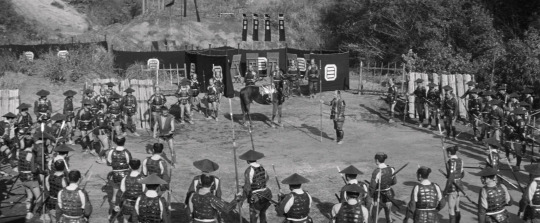



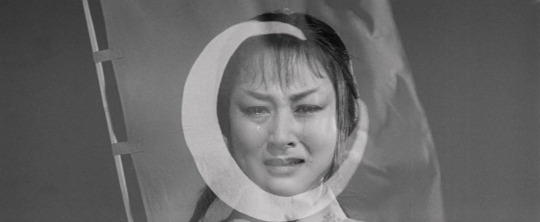



The Hidden Fortress (1958)
Director: Akira Kurosawa
Cinematographer: Kazuo Yamasaki
#dailyworldcinema#the hidden fortress#akira kurosawa#toshiro mifune#cinemetography#cinema#movie stills#japanese film
33 notes
·
View notes
Text
IM TOTALLY NORMAL ABOUT HIM I SWEAR


#emesis blue#tf2 emesis blue#tf2 medic#team fortress 2#tf2#screenshot redraw#aka GUESS WHO FINALLY TOOK THE TIME TO SLOW DOWN N PRACTISE WOO YEAH#posting again cause the last post got hidden#blood
105 notes
·
View notes
Text

Careful with that...
#tf2#tf2 engineer#tf2 pyro#tf2 fanart#team fortress 2#you gotta hide those in a better spot Engie#...oh who are we kidding#Pyro would sniff them out no matter where they're hidden#Fun fact: i goofed on this work originally#Drew the fire inverted so that the yellow was on the edge and the red was on the inside#Should have used a reference beforehand ^^;
11 notes
·
View notes
Text
"the Warrior, the Princess & the Peasants"
Hidden Fortress (1958)
The Akira Kurosawa movie that inspired the structure and some of the character dynamics in the first Star Wars film. The main characters are:
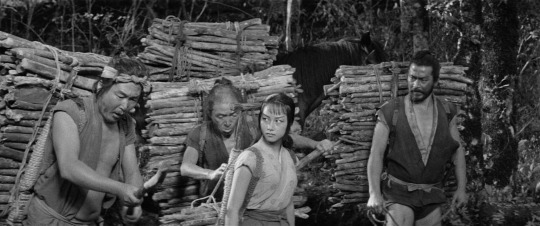
Matashichi and Tohei, the two serfs whose eyes most of the picture is viewed through, Princess Yuki, an uppity young aristocrat on the run from the authorities, who constantly bickers with Toshiro Mifune's battle-hardened general Rokurota.

Star Wars (1973)
In the original concept of Star Wars, the dynamic stayed similar, although more characters were added to the mix.
But you still have the two droids, C-3PO and R2D2 (deriving from the peasants in Hidden Fortress), Princess Leia (loudmouth aristocrat on the run from the authorities), and Luke Skywalker (a battle-hardened general).
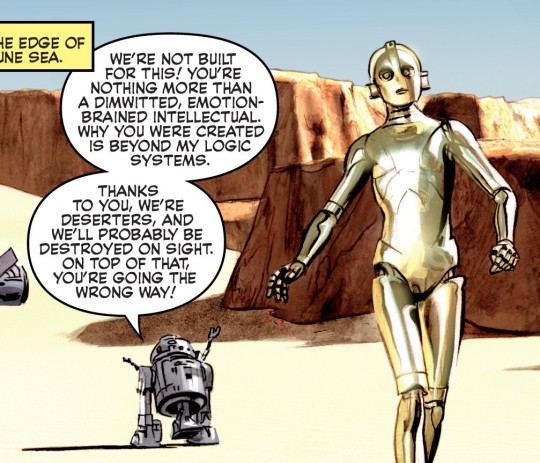
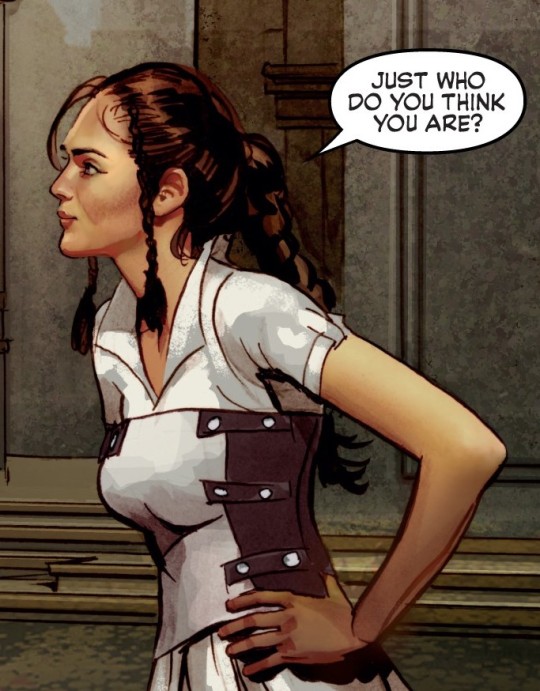
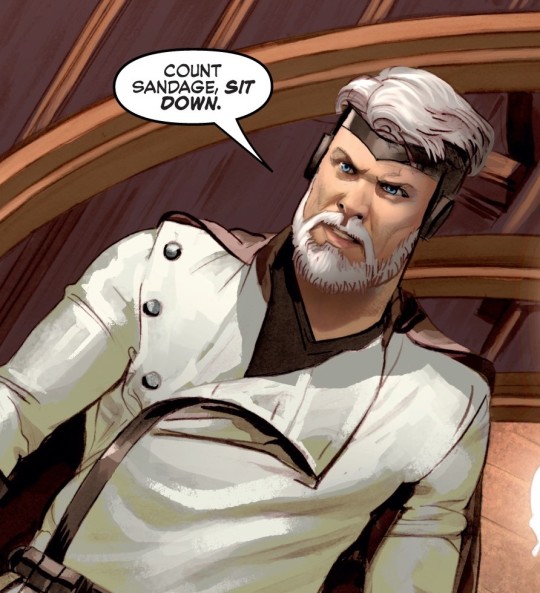
As drafts changed and plot details shifted, Luke Skywalker became the young protagonist, the general character became Obi-Wan Kenobi (whom Toshiro Mifune was originally considered for).
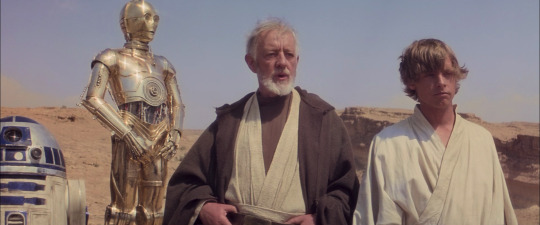
It's not a one-to-one copy, but there is clearly an inspiration. And when you look at the posters at the time?
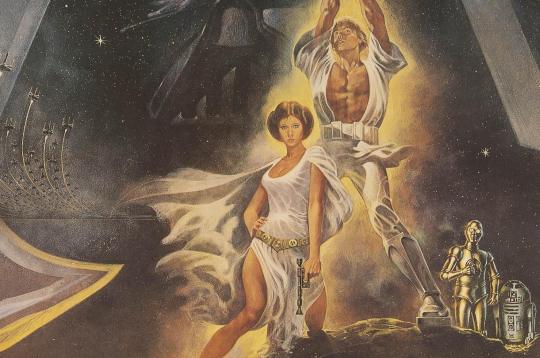
Still Luke, Leia, 3PO and R2.

The Phantom Menace (1999)
As already discussed here, in one of the early drafts of The Phantom Menace, Obi-Wan is the one who rescues the Queen from Naboo and finds Anakin on Tatooine. Qui-Gon only comes into the script once the gang gets to Coruscant.
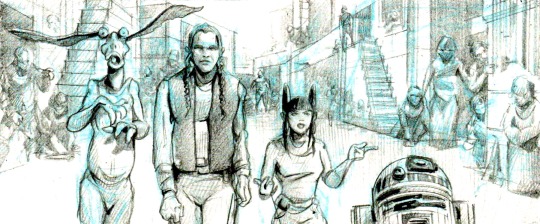
But in this early draft, Obi-Wan is an experienced warrior, who pushes the envelope, eliciting the complaints of princess Queen Amidala (the aristocrat on the run). When on Tatooine, the two "low-ranking" characters are still R2, this time with Jar Jar Binks.
Eventually, for multiple reasons, Obi-Wan was made the Padawan and Qui-Gon was put in early in the script.
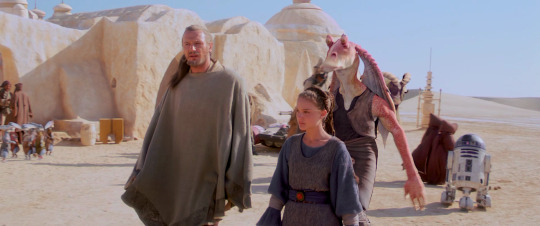
(Fun Fact: before this change was made, there was a draft where Obi-Wan stayed the elder, Qui-Gon was made the Padawan, and then Obi-Wan gets killed by Maul and young Qui-Gon takes on his name, going on to become Alec Guinness' Ben!)
But be it Qui-Gon or Obi-Wan, the warrior in The Phantom Menace is no longer a general with rank authority, he's just a diplomat.
The only reason he's able to do things "his way or the highway" is because 1) he is headstrong and 2) Padmé is undercover and doesn't wanna give it away (as if Qui-Gon and Obi-Wan hadn't already noticed...!)
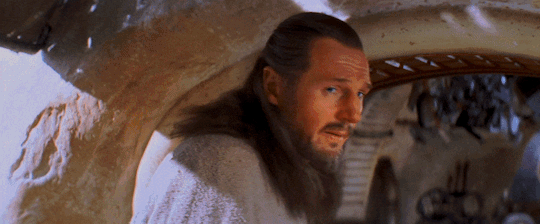
So here we have an interesting reversal of roles: in Hidden Fortress (and kinda in the first Star Wars film), the Princess is the chaotic hellion who must be reined in by the warrior, who's always screaming:
"Princess, ffs! Stop wandering off, they're actively looking for you!"
Here, the warrior is the one going off-book and the Queen is like:
"Stop this at once, you cheeky fellow! We're on the run!"
Finally, as covered in this lengthy post about how The Hidden Fortress informs us of the Jedi's standing within the Republic, Lucas makes it clear that he alternates between projecting the "peasant POV" archetype on the Jedi duo and Jar Jar & R2/Anakin.
There is no clear protagonist in The Phantom Menace, you just have four main characters: the Jedi (who are two separate characters, but functionally are basically one single character), Padmé and Anakin.

All of this to say that just like the themes, these archetypes also echo each other in more ways than one, and it's intentional. As Lucas puts it, it's like a symphony:
"I’m also doing very stylistic ideas, things that are very musical in terms of how I develop themes, and repeat themes. I go do the same thing over and over in certain areas to echo what I have done before. It’s like a symphony more than a movie."
- Star Wars Insider #35, 1997
"I'm approaching these films, for better or worse, like a symphony. I have a lot of themes that I keep repeating over and over again through the whole thing. Different notes and different instrumentation, but when you see all six movies together you'll see that there's a lot of recurring notes being played. [...] And it’s done on purpose. And it’s also done in different facets."
- Star Wars Insider #52, 2000
So yeah.
Just some fun similarities and tidbits I noticed, figured I'd share.
#the hidden fortress#akizuki clan#Princess Yuki#Princess Leia#Queen Amidala#Rokurota#Luke Skywalker#Qui-Gon Jinn#Obi-Wan Kenobi#star wars#akira kurosawa#George Lucas#bts tidbits
115 notes
·
View notes